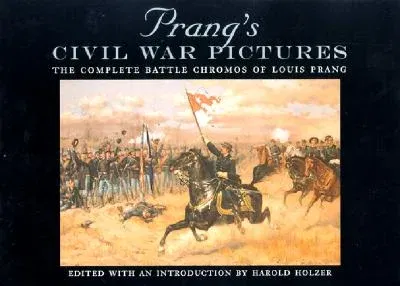During the 1880s, a German-born, Boston-based picture publisher
successfully commissioned the most ambitious series of battle prints
ever published. Louis Prang, best known as the father of the Christmas
card, hired noted military and marine artists to create original scenes
of combat, and then reproduced their works in a wildly popular portfolio
of chromolithographs. He called the set Prang's War Pictures.
They were offered to an eager public accompanied by descriptive texts
that told the story of each engagement through eyewitness recollection
by the heroes of each action. The set proved both appealing and
influential, selling vigorously in various editions for a generation,
and elevating the stature of military illustration in America. For 20
years, Civil War prints for the masses had featured uninspired,
one-dimensional views of armies in hand-to-hand combat.Prang and his
artists demonstrated genuine skill and imaginative perspective. They
showed both real carnage and important technological advances, revealing
both the broad sweep of panoramic battlefields and the intimate action
of individual combatants.
These famously sepia-toned chromos went on to become familiar
illustrations in books and magazines-often offered as definitive
examples of Civil War art. But until now, the complete set of 18 chromos
has never been collected in a single volume. And the original
Descriptive Texts first offered Prang's customers as marketing brochures
to boost sales-a priceless historical archive in and of themselves-have
never been published since, anywhere.Holzer reunites pictures and texts
in an authoritative, milestone volume orchestrating prints and
descriptions that resurrect Prang's original conception of battle art
for the masses for a new generation.
The book also features reproductions of the original works of art that
inspired the prints, created on commission by battle painter Thure de
Thulstrup and naval specialist Julian Oliver Davidson-now housed in art
collections around the country-but seldom seen since they were
commissioned by Prang as models for his ambitious chromolithographs.
This long-needed complete Prang portfolio will undoubtedly become an
essential collectible for Civil War aficionados in the country, as well
as for libraries and university collections increasingly aware of the
importance of art and iconography in defining the Civil War experience
and the impact of Civil War memory.

